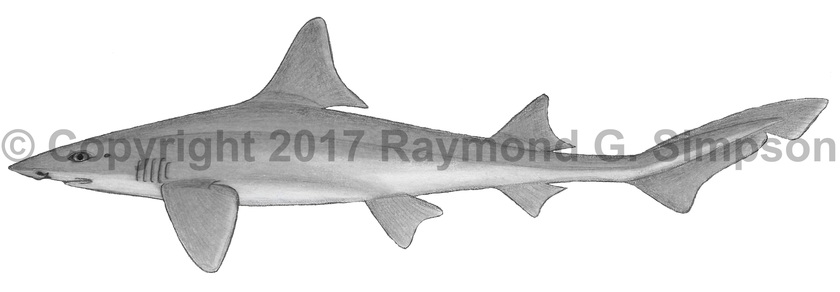
Common Name
Smooth Dogfish
Year Described
Mitchill, 1815
Identification
A small and slender shark with two large dorsal fins. Mouth with upper labial furrows longer than lower furrows. Teeth small and low with stumpy cusps. Upper jaw: 64-74 rows. Lower jaw: 58-75 rows. Eye large with a prominent spiracle less than eye diameter behind it. Nostril with projecting tabs. Distance between nostrils 2.7-3.6% TL. Dorsal fins lack spines. Second dorsal fin about 75% as high as the first. First dorsal origin over rear base of pectoral fin. Second dorsal fin origin anterior to anal fin origin but well behind pelvic free tip. Pectoral fin angular. Pelvic and anal fins much smaller than second dorsal fin. No precaudal pits. Caudal fin with a prominent rounded lower lobe. Skin with overlapping *single-pointed denticles with 3-4 ridges. Precaudal vertebrae: 86-90.
Color
Body uniformly gray to gray-brown above grading to pure white or cream below. No spots or markings on body. Juveniles with thin black edging on dorsal fins.
Size
Maximum size to 150cm TL. Mature adults at 90cm TL.
Habitat
Found most commonly in shallow coastal waters from the surface to 480m. Goes into deeper water during winter. Can tolerate brackish water estuaries for short periods.
Range
From the northeastern U.S. to Florida and the Gulf of Mexico, to the islands of the Caribbean and Bermuda, and the southwestern Atlantic from Brazil to Argentina.
References
Castro, J.I. 2011. The Sharks of North America. Oxford University Press, 640 pp.
Compagno, L., M. Dando, and S. Fowler. 2005. Sharks of the World. Princeton University Press, 480 pp.
Heemstra, P.C. 1997. A review of the smooth-hound sharks (genus Mustelus, family Triakidae) of the western Atlantic Ocean, with descriptions of two new species and a new subspecies. Bulletin of Marine Science, 60(3), 894-928.
Rosa, M.R., & O.B.F. Gadig. 2010. Taxonomic comments and an identification key to species for the Smooth-hound sharks genus Mustelus Link, 1790 (Chondrichthyes: Triakidae) from the Western South Atlantic. Pan-American Journal of Aquatic Sciences, 401-413.
Other Notes
The status of the Caribbean insular populations (described as Mustelus canis insularis in Heemstra (1997) from Caribbean islands) and the southwestern Atlantic populations need to be investigated. They could possibly be distinct species. Caribbean populations occur at a significantly deeper depth and have slight differences in body proportions.